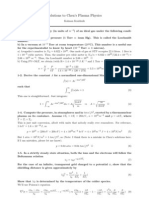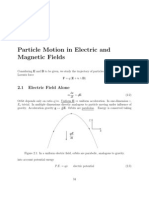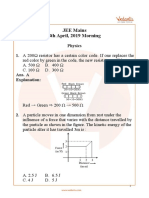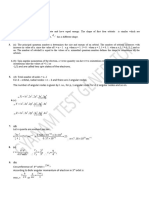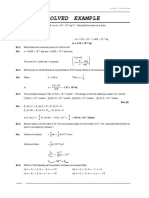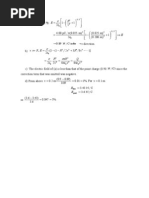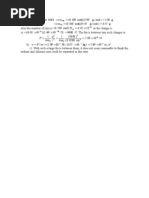Problem43 05
Uploaded by
IENCSProblem43 05
Uploaded by
IENCS43.
5: a) → → →
point in the same direction for a proton. So if the
U = μ ⋅ B = − µ z B. N and S
spin magnetic moment of the proton is parallel to the magnetic field, U < 0, and if they
are antiparallel, U > 0. So the parallel case has lower energy.
The frequency of an emitted photon has a transition of the protons between the two
states given by:
∆E E − E− 2 μz B
f = = + =
h h h
2(2.7928 )( 5.051 ×10 −27 J T )(1.65 T )
= −34
= 7.02 ×10 7 Hz.
(6.63 ×10 J ⋅ s)
c 3.00 ×10 +8 m s
⇒λ = = = 4.27 m. This is a radio wave.
f 7.02 ×10 7 Hz
b) For electrons, the negative charge means that the argument from part (a) leads to
1 → →
the m s = − state (antiparallel) having the lowest energy, since N and S point in
2
opposite directions. So an emitted photon in a transition from one state to the other has a
frequency
∆ E E − 12 − E + 12 − 2 µ z B
f = = =
h h h
But from Eq. (41.22),
e − (2.00232 )e
μ z = −(2.00232 ) Sz =
2me 4me
(2.00232 )eB (2.00232 )(1.60 ×10 −19 C)(1.65 T)
⇒f = =
4πm e 4π (9.11 ×10 −31 kg)
⇒ f = 4.62 ×10 10 Hz
c 3.00 ×10 8 m s
so λ = = = 6.49 ×10 −3 m.
f 4.62 ×10 10 Hz
This is a microwave.
You might also like
- Suggested Solution To 2010 Jc2 Physics Prelims H2 P1: Section A (MCQS) Ans: BNo ratings yetSuggested Solution To 2010 Jc2 Physics Prelims H2 P1: Section A (MCQS) Ans: B17 pages
- JEE Main 2019 Question Paper With Solutions (8th April - Morning)No ratings yetJEE Main 2019 Question Paper With Solutions (8th April - Morning)67 pages
- Module I: Electromagnetic Waves: Lectures 6-7: EM Waves in Confined SpacesNo ratings yetModule I: Electromagnetic Waves: Lectures 6-7: EM Waves in Confined Spaces29 pages
- Assignment - 2 - Electric Charges and Fields-Neet-Solution PDFNo ratings yetAssignment - 2 - Electric Charges and Fields-Neet-Solution PDF11 pages
- Quantum Mechanics Davisson and Germer Experiment100% (2)Quantum Mechanics Davisson and Germer Experiment15 pages
- 06-Atomic Structure - Telegram - @JEE - BOOKSNo ratings yet06-Atomic Structure - Telegram - @JEE - BOOKS9 pages
- Massachusetts Institute of Technology Opencourseware 8.03Sc Fall 2012 Problem Set #7 SolutionsNo ratings yetMassachusetts Institute of Technology Opencourseware 8.03Sc Fall 2012 Problem Set #7 Solutions8 pages
- TIMES PHY ELECTRIC CHARGES 60 Q KEYS HINTSNo ratings yetTIMES PHY ELECTRIC CHARGES 60 Q KEYS HINTS20 pages
- Electron Beam-Specimen Interactions and Simulation Methods in MicroscopyFrom EverandElectron Beam-Specimen Interactions and Simulation Methods in MicroscopyNo ratings yet
- Feynman Lectures Simplified 2B: Magnetism & ElectrodynamicsFrom EverandFeynman Lectures Simplified 2B: Magnetism & ElectrodynamicsNo ratings yet
- Feynman Lectures Simplified 2C: Electromagnetism: in Relativity & in Dense MatterFrom EverandFeynman Lectures Simplified 2C: Electromagnetism: in Relativity & in Dense MatterNo ratings yet
- Problems in Quantum Mechanics: Third EditionFrom EverandProblems in Quantum Mechanics: Third EditionD. ter Haar3/5 (2)
